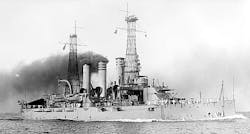Blog: Navy's newest destroyers evolve to fill traditional battleship roles
THE MIL & AERO BLOG, 12 Nov. 2013. U.S. Navy leaders have launched the first in a new class of surface warships designed for shore bombardment -- a job that traditionally belongs to battleships and heavy cruisers.
This new warship, which emphasizes naval surface fire support, is neither a battleship nor a cruiser, but is large enough to be either one. It's the USS Zumwalt (DDG 1000), and the Navy insists on calling it a destroyer, even though its core mission is far from what one would expect from a destroyer.
The Zumwalt is 600 feet long, nearly 81 feet wide, and displaces 14,800 tons, which makes this vessel larger than the Navy's fleet of Ticonderoga-class cruisers (CG 47), WAY larger than the Navy Arleigh Burke-class destroyers (DDG 51), and is only slightly smaller than the 1950s-vintage Navy nuclear-powered Long Beach-class cruiser.
The Zumwalt, in fact, is roughly the mass of a Virginia-class battleship (BB 13), which was at sea from 1906 to 1920. The Zumwalt, however, is longer than the Virginia, which was only 441 feet long compared to the Zumwalt's 600 feet. The new "destroyer" is the largest vessel seen in a long time -- perhaps ever -- in and around the Bath, Me. shipyards where it is still under construction.
Curiously, despite everything to the contrary, the Navy insists on calling this behemoth a destroyer.
Think of a modern destroyer and several things come to mind. This kind of vessel is supposed to be a relatively small, fast, and maneuverable ship with plenty of anti-aircraft missiles, powerful radar, and advanced anti-submarine warfare (ASW) capability. The Zumwalt isn't that kind of ship.
This ship is built around the Advanced Gun System (AGS), a 155-millimeter cannon that is designed to hurl special shells as far as 83 nautical miles at a rate of 10 rounds per minute. That's a lot of firepower, and might even rival the destructive power of the Iowa-class battleships that the Zumwalt is designed to replace.
The four World War II-era Iowa-class ships -- the Iowa, the Wisconsin, the New Jersey, and the Missouri -- each had nine 16-inch guns as their main armament. They fired big shells, but with a range of just 20 miles -- far shorter than the Zumwalt's armament.
One of the biggest selling points for the Zumwalt-class destroyer is its heavy use of automation. The big ship needs just 140 officers and enlisted personnel to operate. The cruiser Long Beach needed a crew of 1,100 to operate, while the old Virginia-class battleships needed about that many. The Iowa-class ships needed 1,800 to 2,700 sailors to operate.
The Zumwalt should be ready for deployment at sea in two or three more years. It's scheduled to have two sister ships in the class, the USS Michael Monsoor and the USS Lyndon B. Johnson. It's doubtful that any more of these kinds of ships will be built.


